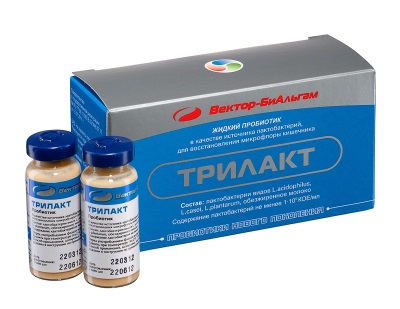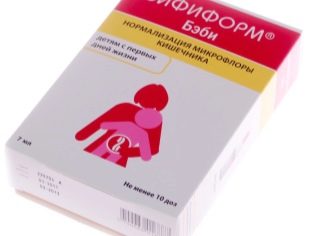What are probiotics and which ones are better?
In the treatment of babies, parents have to deal with different groups of drugs. One of them is probiotics, which are very popular now and are prescribed for changes in the composition of the intestinal microflora in diseases and for the prevention of digestive problems. Let's look at this group of drugs in more detail and find out which of the probiotics are best given to children.
Probiotics are drugs with biological activity that contain live bacteria that are members of the normal intestinal flora.
Indications for use
The scope of use of probiotics is mainly associated with various disorders of the digestive function. Such drugs are indicated for:
- Irritable bowel syndrome.
- Inflammatory diseases of the digestive tract.
- Infectious diarrhea.
- Diarrheacaused by taking antibiotics.
- Acute infectious diseases.
- Allergic skin lesions.
- Hepatic encephalopathy.
- Constipation.
- Necrotizing enterocolitis.
Contraindications
Probiotics should not be prescribed for pathologies affecting the work of the immune system, for example, for HIV, leukemia, after radiation therapy, organ transplantation and in some other conditions.
Difference from prebiotics
The name of these two groups of drugs are very similar, so they are often confused. It should be noted that the effect of both prebiotics and probiotics is similar, because each of the groups of these agents normalizes the intestinal microflora. That is why both groups are used in the complex for the treatment of digestive problems, including dysbiosis. As for differences, to avoid confusion, you need to remember that:
- Probiotics are living microorganisms that belong to the normal intestinal microflora.
- Prebiotics are organic chemicals that have the ability to create excellent conditions for the reproduction of normal intestinal microflora.
What are probiotics, why they are needed and how they differ from prebiotics, see the video of the Union of Pediatricians of Russia.
History of creation
The first probiotic, which studied and began to use humanity for the purpose of producing lactic acid products, was called Bulgarian lactobacillus. This microorganism was isolated in Bulgaria from vegetable raw materials. Probiotics got its modern name in the 20th century in the 80s. It is based on the phrase "for life", which is fully consistent with the purpose of such drugs. The first drugs were single component and included one type of bacteria. Later began to produce mixtures of microorganisms, as well as their complexes with prebiotic substances.
Requirements for probiotics
The composition of probiotics should be the strains of those microorganisms, the effect of which is clinically proven. It is also important that the drugs are suitable for age, since the intestinal microbiocenosis differs at different ages. No less important requirements for probiotic preparations are safety, antibiotic resistance and acid resistance.
Should they be used by children breastfed?
In infants fed with breast milk, dysbacteriosis occurs much less frequently than in artificial children, since mother's milk provides the crumbs with a sufficient number of beneficial microorganisms.
However, babies breastfed Probiotics can also be beneficial because:
- Dysbacteriosis in infants can be caused by long-term antibiotics or an intestinal infection.
- Probiotics help eliminate acute diarrhea of infectious nature.
- Such medicines improve the condition of infants with allergic skin diseases.
- Receiving probiotics helps to improve digestion in children with constipation.
- Due to their ability to increase immunity, probiotics can benefit from influenza and acute respiratory infections, and are also used for their prevention.
- The undoubted benefits of probiotics are noted for babies with lactase deficiency and hepatic encephalopathy.
Beneficial features
Probiotics are capable of:
- Synthesize proteases, organic acids and other substances that inhibit the growth of harmful bacteria in the intestines.
- To force out the pathological flora by competing for the receptors by which microorganisms remain in the intestine.
- Stimulate the immune response of the child's body by increasing the production of cytokines, mucin, immunoglobulins, T-cells and other factors.
- Reduce the permeability of the intestinal mucosa.
- Destroy toxic substances that are abnormal flora in the intestine.
- Participate in the synthesis of vitamins B and vitamin K.
- Assist in the absorption of protein and carbohydrate foods, as well as other nutrients.
ABOUT taking probiotics after antibiotics and during antibiotic therapy, read another article.
Principle of action on the body
Once in the body of the child, the bacteria pass through its digestive tract and linger in the large intestine, attaching to its mucosa. Each bacterium forms a colony, with the result that the number of useful flora increases significantly.
For newborns
The baby is normal for the first time faced with bacteria in the neonatal period. Even in the process of childbirth during the advance along her mother's birth canal, the baby is found with microorganisms that settle on its mucous membranes and skin, and also enter the intestine. The first applications to mother's breast, giving valuable droplets of colostrum, contribute to the colonization of the infant's digestive tract with the necessary microflora.
The main prebiotic during this period of life of the baby is mother's milk. It contains all the valuable microorganisms that become a source of colonies in the infant intestine. If the baby is deprived of breast milk, the risk of changes in the composition of the microflora increases, so the doctor will recommend mixtures containing bifidobacteria and lactobacilli.
For older children
The most common purpose of probiotics in children older than one year is associated with antibiotic therapy. Antibacterial drugs do not have a selective effect, so they equally actively destroy both harmful bacteria and beneficial microorganisms. And often with long-term use of antibacterial agents, the number of bifidobacteria and lactobacilli in the intestine is so reduced that it leads to dysbacteriosis.
In this case, probiotics are prescribed as a prophylactic agent if the child has to take antibiotics for a long time, and as a therapeutic drug that helps to restore the intestinal flora after antibacterial treatment.
Current research confirming effectiveness
A study of 2005, which was carried out for six months, studied the effect of a mixture of lacto, bifidus and propionobacteria on children with irritable bowel syndrome.The results obtained confirmed the effectiveness of the use of such a probiotic mixture in the treatment of this pathology.
Also in 2005, controlled studies were conducted in Israeli pediatric clinics. In 14 medical centers tested long-term use of a mixture of bifidobacteria and lactobacilli for children with respiratory disorders. The study showed that probiotics helped to reduce the duration of fever, reduced the duration of diarrhea episodes and reduced the list of indications for prescribing antibiotics. Also during the study, it was determined that the role of lactobacilli in this case was greater than that of bifidobacteria.
Against colic
At the University of Turin, the effect of lactobacilli on intestinal colic in newborns was investigated. It was found that in infants suffering from colic, the intestinal flora contains less lactobacilli and more gram-negative anaerobic bacteria.
The babies were prescribed 7 days of live lactobacillus at a dose of 100 million and noted that 95% of babies had colic symptoms, while in the control group whose babies were given simethicone, this indicator was only 7%.
For intestines
A study in Finland in which the expectant mother was prescribed probiotics before birth and continued to give drugs to babies after birth showed that this tactic had a positive effect on the maturation of the intestinal immunity in children. At one-year-old age, the babies had their immunoglobulins set and found that this level was higher in babies receiving breast milk and probiotic.
A study of babies in Taiwan who were born underweight has shown the effectiveness of prophylactic use of probiotics to prevent necrotizing enterocolitis. The babies were given preparations with live bacteria twice a day and noted that the incidence of enterocolitis and the severity of the disease decreased. A similar study was also conducted in Israel. It confirmed the effectiveness of the use of a probiotic mixture to reduce the severity of enterocolitis.
Types
Depending on the state of aggregation, all probiotic preparations are divided into dry as well as liquid. Each of these types has its own advantages of use.
Liquid
The advantage of this type of probiotics is the preservation of the viability of bacteria, so the tool is active immediately after entering the intestine. In addition, probiotic in liquid form is easier to dose, and the ability to divide the dose by the number of drops makes this type of medicine preferable for a child of the first year of life. In addition, other substances can be added to the liquid probiotic, for example, one of the prebiotics or vitamin mixtures.
Dry
The first probiotics were presented exactly in the dry form. Bacteria for such preparations were dried using lyophilization (freezing followed by drying in a vacuum chamber). Such processing puts bacteria into a state of anabiosis, when their vital activity is suspended until it gets into favorable conditions.
The main advantage of any dry probiotic is the possibility of long-term storage. Dried bacteria are placed in capsules, vials or ampoules for up to two years. However, due to lyophilization, this type of probiotic is less active. Bacteria require several hours (from 8) to exit from anabiosis, attachment to the intestine and start vigorous activity. During this time, part of the drug is eliminated from the body.
Groups
The composition of probiotics includes lactobacilli, gram-positive cocci, bifidobacteria, yeast, lactic acid streptococcus, non-pathogenic E. coli and other microorganisms.
All probiotic medicines are divided into:
- Single component. They contain only one type of bacteria.
- Multicomponent. The composition of such probiotics includes several types of bacteria.
- Combined. In addition to bacteria, they contain prebiotics.
- Sorbed. In such tools, bacteria are fixed on the sorbent (activated carbon).
The names of popular probiotics and their overview in the table
Title | Active substance | Release form | Age of application |
Bifidobacterium bifidum | Powder Bag | From the neonatal period | |
Bifidobacterium infantis Enterococcus faecium Lactobacillus acidophilus | Capsules | Since birth | |
Probifor | Bifidobacterium bifidum, adsorbed on activated carbon | Powder bags, capsules | Since birth |
Saccharomyces boulardii | Powder bags, capsules | From 1 year | |
Narine | Lactobacillus acidophilus | Powder, tablets, capsules | From 5-10 days after birth |
Florasan-D | Bifidobacterium infantis Bifidobacterium bifidum Lactobacillus rhamnosus Bifidobacterium longum | Capsules | From the age of 7 |
Florasan-A | Lysate Saccharomyces cerevisiae Bifidobacterium bifidum Lactobacillus rhamnosus Bifidobacterium longum | Capsules | Children over 7 years old |
Bifidum-multi-1 | Bifidobacterium bifidum Bifidobacterium infantis Bifidobacterium breve | Powder Sachet Capsules | Since birth |
Bifidum-multi-2 | Bifidobacterium bifidum Bifidobacterium longum Bifidobacterium breve Oligofructose Pectin Inulin | Capsules | From 3 years old |
Streptococcus thermophilus TH-4 Bifidobacterium BB-12 ™ | Bottles with oil solution | Since birth | |
Bifiform Baby | Bifidobacterium lactis Lactobacillus gg Vitamins | Sachet Powder Chewable Tablets | Powder - from 12 months, tablets - from 2 years of age |
Normospectrum Baby | Lactobacillus casei Bifidobacterium bifidum Lactobacillus plantarum Lactobacillus acidophilus Bifidobacterium longum Bifidobacterium infantis Bifidobacterium breve Vitamins Inulin Minerals Oligofructose | Capsules | From 18 months |
Lactobacillus acidophilus Kefir Fungi | Capsules | From 3 months | |
Biovestin | Bifidobacterium adolescentis MC-42 Prebiotics | 12 ml vials of liquid | Since birth |
Biogaya | Lactobacillus reuteri | 5 ml bottles, tablets, powder in sachet | Drops and powder from birth, pills - from the age of 3 |
Symbiolact compositum | Lactobacillus casei Bifidobacterium bifidum Lactobacillus acidophilus Lactococcus lactis Bifidobacterium lactis Lactobacillus salivarius | Sachet powder | Children from 3 years |
Primadofilus children | Bifidobacterium infantis Lactobacillus rhamnosus Bifidobacterium longum Lactobacillus acidophilus | Powder in vials | Since birth |
Sporobacterin | Bacillus subtilis 534 | Vials of 10 ml | Children over one year old |
Normoflorin-L | L. acidophilus Lactit Amino Acids Trace elements Organic acids Vitamins | Bottles of 100 ml | Since birth |
Normoflorin B | Bifidobacterium bifidum Bifidobacterium longum Lactit Amino Acids Trace elements Organic acids Vitamins | Bottles of 100 ml | Since birth |
Laktomun | Bifidobacterium lactis Bifidobacterium bifidum Lactococcus lactis | Sachet powder | Since birth |
How to choose the best?
The study, during which it was determined whether the composition indicated on the package corresponds to the actual composition of the probiotic, revealed that the drugs Linex, Biogaya, Laktomun and Bifiform completely correspond to all data. The second stage of the study was to determine the amount of the drug that enters the intestine. This stage found out that from 40 to 90% of bacteria of the majority of agents does not reach the intestinal lumen. Only Bifiform was able to overcome the hydrochloric acid of the stomach without loss and hit the intestine in the right quantity.
When choosing a probiotic, use these tips:
- Carefully read the label of the drug to make sure that you get the strains of microorganisms necessary for treatment, and the expiration dates of the probiotic are not violated.
- It is better not to order such funds on the Internet, since you risk getting a fake or expired drug.
- Choose a product from a trusted manufacturer that has proven itself. For companies that work with probiotics for a long time, it is important that their products are of high quality and their reputation does not suffer.
How to use?
Both capsule and liquid forms of probiotics should be drunk after meals about an hour or 20-60 minutes before meals. To reduce the difficulty of taking the right dose of the drug, the medicine can be stirred in a small amount of water.
It is important to observe the dosage and frequency of probiotic administration recommended by the doctor, as well as to monitor the storage conditions of the drug. Most often, the course of taking such a drug is 2-3 weeks. When prescribed to eliminate diarrhea, probiotic should be taken 2-4 days before stool normalization.
Probiotics should not be included in the daily diet of the crumbs.For more on this, see the transfer of Dr. Komarovsky.
Reviews moms
The opinion of moms about probiotics is rather contradictory, since there are quite a few women who do not consult with their doctor about their admission, but select both the drug itself and the duration of the course and the dose of the medicine on their own. For this reason, reviews of mommies about probiotics cannot be considered 100% reliable. In addition, the children may have a different clinical picture and many other factors affecting the effectiveness of treatment.
However, there are drugs that are positive in most cases. These include Bifiform Baby and Biogai. Moms also attributed the good probiotics to Laktomun and Primadofilus. But Linex, Latium and other probiotic agents often cause a negative assessment, although each case of a problem with the intestinal microflora is individual and you should not fully rely on the reviews of other mothers.
On the history of probiotics, their effectiveness and the benefits of prebiotics, see the following video.























